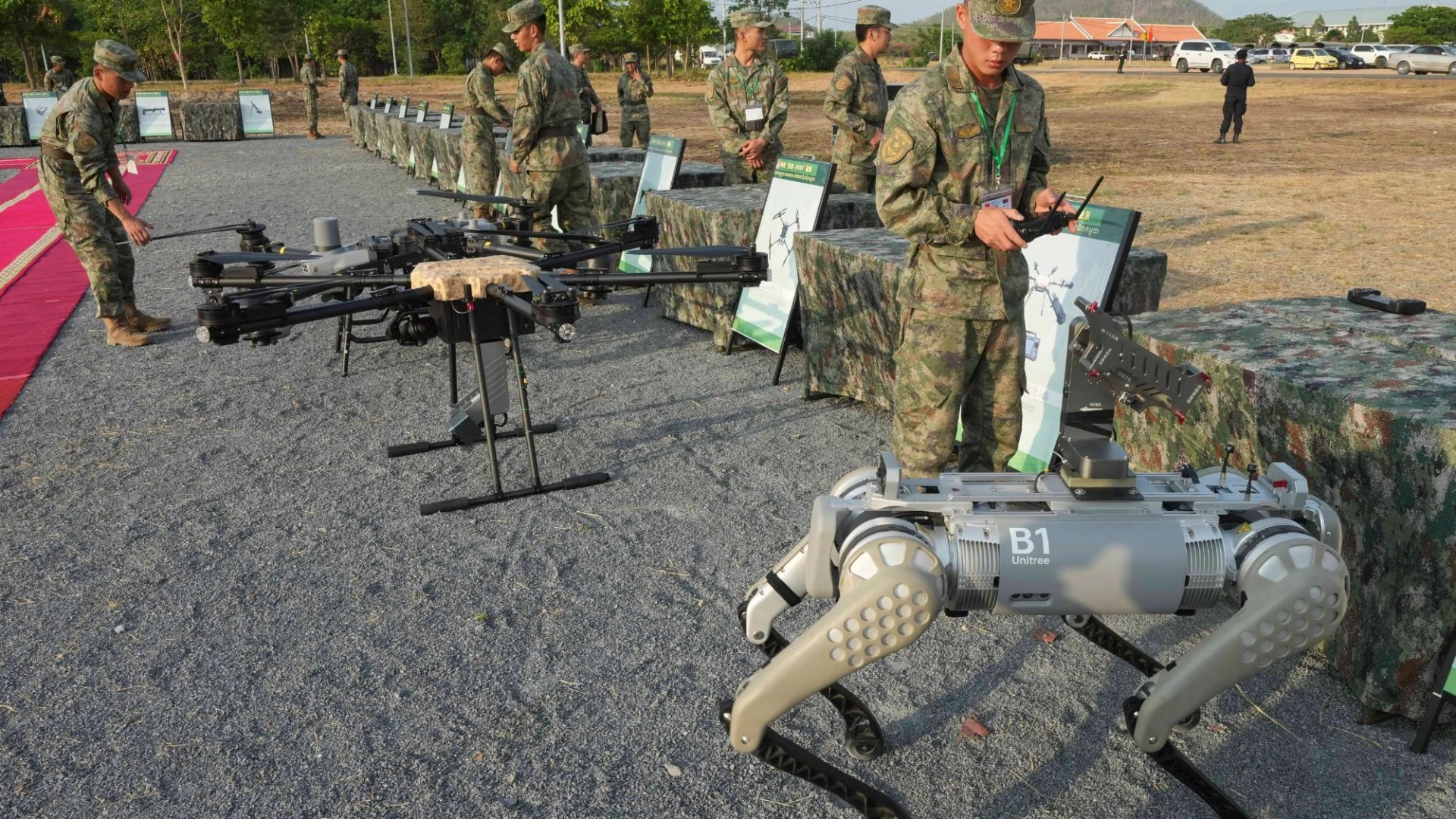FOR months, terrorist Hezbollah operatives lived their lives as normal, communicating with pagers and walkie-talkies in order to avoid eavesdropping from Israel.
Little did they know that the old-fashioned gadgets had been primed with explosives – that is until this week, when they were triggered, killing at least 20 and injuring thousands.
22

22

22
It’s one of the most daring acts of spycraft in recent years, a double-whammy attack that had bombs going off in people’s pockets and left Iran-backed terrorists Hezbollah scared to open their fridges.
But it’s far from the only time agents have used ingenious tech and built booby-traps to turn everyday objects into weapons that kill.
Philip Ingram MBE, a former senior British Military Intelligence officer, spoke to The Sun about just how deadly these gadgets are.
Speaking of his own experience in conflicts, he said: “We’ve seen toys, everyday objects rigged with explosives – you worry constantly.
“We’ve had umbrellas with poisoned pellets used in the streets of London. We’ve had Novichok used in Salisbury. People have even explored microwave weapons.
“The use of novel weapons in warfare is not unusual.”
From a covert gun that fires a frozen dart made of shellfish poison to an exploding car headrest, these devices prove one thing – that if a spy agency makes a target of you, you have good reason to be fearful.
Exploding headrests
While eavesdropping might be the most common goal of device tampering, this week’s attacks are far from the first time it has been used to deadly effect.
And Israel, in particular, are masters of it. Yahya Ayyash, who was born in 1966, went on to become the chief bomb maker of the terrorist group Hamas.
He was nicknamed “The Engineer”, and is credited with advancing suicide bombing as a tactic – though of course without doing it himself.
But thanks to a booby-trapped device, he still met a grizzly end.
In 1996, Israel’s internal security agency, Shin Bet, managed to trick him into answering a call from his father using a Motorola cell phone smuggled into Gaza by a collaborator.
An Israeli plane overhead picked up the conversation, letting them confirm it was him on the phone.
Inside the phone was 50g of explosives. He was killed instantly. This is far from the only case study too.

22

22

22
In 2008, Imad Mughniyeh – then number two in charge of Hezbollah – was out in Damascus celebrating the 29th anniversary of the Iranian revolution, that saw the imposition of a savage theocratic regime.
But minutes after leaving, a blast ripped apart his car and echoed in the surrounding streets.
While he was out, the headrest in the driver’s seat had been swapped out for a dupe that contained a small high-explosive charge. He was killed instantly.
‘Heart attack gun’
With the recent news and Israel’s history of carrying out similar attacks, you’d be forgiven for thinking that it was just them who did this.
But that could not be further from the truth. America’s own CIA – by definition – is very secretive about the gadgets and devices they have in their arsenal.
Occasionally, however, we see a taste of what such an organisation is capable of.
In 1975, a congressional hearing was held that revealed the CIA was in possession of a weapon that could kill without a trace.
It was nicknamed the “heart attack gun” because for any victim the official cause of death would always be a heart attack.

22

22

22
The gun fired a frozen dart of water and shellfish toxin.
When it entered the victim, the dart would melt, releasing the poison into the victim’s body.
The shellfish toxins would then shut down the cardiovascular system, perfectly mimicking a heart attack and causing death in just minutes.
The only trace left would be a small red mark where the dart entered the body, which would be impossible to spot unless you knew what you were looking for.
Its development began when a young researcher at the CIA, Mary Embree, was asked to find an undetectable poison.
Due to the secrecy surrounding the weapon, it is unknown if it was ever used.
Taking a pop at Castro would have been a major international incident and could indeed have led to a nuclear war
Anthony Glees, terrorism expert
However, the Senate committee that exposed the gun’s existence also investigated plans to assassinate leaders such as Cuba’s Fidel Castro and Rafael Trujillo, leader of the Dominican Republic.
Such an operation was unlikely to happen, however.
Speaking to the Daily Star, terrorism expert Anthony Glees said: “Not only was this likely to be impossible unless there was a massive lapse of security around someone like Castro but the perpetrator would be easy to identify.
“An American assassin taking a pop at Castro would have been a major international incident and could indeed have led to a nuclear war given the protection Cuba was getting from the Soviet Union.”
Kiss of death
The 1960s, while being a time of intense rivalry and espionage between East and West, was also a decade of incredible glamour.
It was only inevitable then that they would combine – in deadly fashion.

22

22
At a West Berlin checkpoint in 1965, the US intercepted a KGB agent carrying what looked to be a normal tube of lipstick. But it was in fact a gun.
The device – which could be fitted with an actual tube of lipstick – was able to deliver a single 4.5mm shot.
It worked by pressing the barrel into the side of the target – delivering what has been dubbed a “kiss of death”.
The Cold War device is now on display at the spy museum in Washington DC.
Sonic weapons

22

22
Sometimes, the origin of such spy-weapons is much less clear.
Philip explained: “I have seen research into sound weapons – where by sending out a wave a particular frequency, it vibrates the diaphragm of people’s bodies and makes them feel violently ill.”
In recent years, US diplomats stationed in embassies around the world have reported strange symptoms of dizziness, headaches, difficulty maintaining concentration and a painful sound in their ears.
The phenomenon was dubbed Havana syndrome, as it was there in Cuba’s capital that it was first reported in 2016.
It was like a dentist drilling on steriods
FBI agent Carrie and victim of a possible directed energy victim
Thousands of people have been affected by it, yet brain scans have shown no evidence of brain injuries.
It remains unclear exactly what – or who – is causing the bizarre symptoms.
But many suspect that these diplomats are the target of Russian “directed energy” weapons.
In April this year, a media investigation by The Insider uncovered evidence that connected members of Russian Military Intelligence Unit 29155 to the timings and locations of the incidents.
The investigation revealed that an officer within the unit had been rewarded for work on developing “non-lethal acoustic weapons”.

22

22
Nonetheless, Philip reminded that the origin remains unconfirmed and therefore claims that it is a hostile actor are “speculation”.
One victim, an FBI agent called Carrie, told CBS 60 Minutes about an experience she had in 2021.
She said: “Bam, inside my right ear, it was like a dentist drilling on steroids.”
Eventually, she said, she passed out and later had difficulty with her memory.
Although less powerful than what was potentially being used by the Russians, so-called sonic cannons and other acoustic devices have been used by militaries and police forces in the past, including one incident in which the Chinese military deployed them to disrupt Philippine government boats.
Dystopian dogs
Given how terrifying an invisible weapon may sound, you may think you’d prefer to face a foe you can actually see.
But you’d be wrong if this is what you’re up against because once you’ve seen this, it’s seen you – which means it’s already too late.
You go into China, you go into North Korea, you go into Russia, your hardware will be tampered with either physically or electronically
Philip Ingram MBE, former senior British Military Intelligence officer
In May of this year, China revealed to the world a weapon that looks straight out of Black Mirror.
Footage of military drills with Cambodia shows a robot dog with an automatic rifle mounted on its back, leading an infantry unit into a building.
Robot dogs are extremely versatile, able to cross almost any terrain with ease.
And combined with AI and drones, they are another terrifying sign that warfare has entered a new era – impersonal and extremely deadly.
Man’s best friend indeed – so long as you’re on the right team.

22

22

22
Mobile killers
The images and footage that have emerged from Lebanon over the last couple of days shed some light on the dramatic events of the last few days.
In one piece of footage, people can be seen wandering around a supermarket like it was any other day when out of the blue an explosion rips out.
Confused people look around, expecting a missile strike or suicide attack – when in fact the blast came from the pager of someone inside the store.

22
Just one day later, further blasts came this time from walkie-talkies owned by the terrorists.
One video even shows an explosion happening at the funeral of someone who died in the attack from the day before.
Philip explained: “It’s a very sophisticated attack. It would have taken months and months of planning and a lot of preparatory activities to make sure that they could get it to work.”
Hezbollah had previously encouraged their members to stop using their mobile phones to avoid infiltration from Israeli and US spyware.
Israeli agents within the terrorist group would then have been able to give feedback about what devices they were switching to.
“It’s what’s officially known as a supply-chain attack,” said Philip.

22

22

22
“You interrupt the supply chain to carry out modifications to different devices, and then put them back without anyone realizing that they’ve been interfered with.”
“And it happens more often than people think,” he added.
While in this case the devices were modified with explosives, interceptions like these are usually used to insert spyware and listening devices.
Philip said: “You go into China, you go into North Korea, you go into Russia, your hardware will be tampered with either physically or electronically.”
If your device does get modified, it can then be used to spy on you – and you wouldn’t even know it’s switched on.
“Anything that you do on your phone, on the connected device, I work on the principle that somebody’s listening to it somewhere. If you work on that principle, then you’ll stay safe,” he added.
Rise of drone warfare
By Iona Cleave
DRONES have been deployed in the war in Ukraine on an unprecedented scale as thousands are used daily to hunt down enemy forces, guide artillery and bomb targets – transforming modern land warfare.
Ukraine has become increasingly reliant on first-person-view (FPV) drones — nimble, target-seeking, kamikaze unmanned aerial vehicles (UAVs).
Since early 2023, the cheap, explosive, flying machines have become one of Kyiv’s biggest success stories after its military ran perilously short on munitions due to long-stalled Western weapon shipments.
The attack UAVs have come to define the conflict, helped by constant streams of footage filmed onboard as they tail troops, blast Russian positions or smash into tanks worth millions with ruthless precision.
The potent quadcopters cost around £300, are largely made from off-the-shelf pieces of kit and as demand soars, an army of civilians are helping to assemble them in their homes.
Some are fitted with grenades or homebuilt bombs, others are used for reconnaissance missions to identify enemy positions and guide artillery fire.
Now, almost every fighting brigade in Ukraine has an assault drone company.
With the 600-mile front frozen in hellish trench warfare, the success of FPVs on the battlefield is “undeniable”, according to the commander of Ukraine’s attack drone operations.
The senior special forces officer “Arsenal” told The Sun the quadcopters-turned-munitions now successfully blitz Putin’s targets in three out of five operations.
And as the war moves into what Arsenal calls a more “technological phase”, he argued FPVs are increasingly vital to Ukraine’s success.
He said: “If Mavic (surveillance) drones are our eyes – for the adjustment of artillery fire, withdrawal of groups to positions, reconnaissance – then FPV drones are our sword, our strike force.”
Over two thirds of Russian tanks destroyed by Ukraine in the first half of 2024 were taken out using FPV drones, a Nato official told Foreign Policy.
Their long-range capabilities also save countless lives as the drone operator can be stationed away from the frontline.
And drones are not just used on the battlefield, both Ukraine and Russia are hitting targets hundreds of miles deep into enemy territory using long-range UAVs.
They are highly cost effective means to blitz factories making weapons, military bases or energy facilities.
Yet, in a constant game of cat and mouse, both sides are developing increasingly sophisticated means of stopping drones using electronic warfare.
In response, Russia and Ukraine are racing to develop UAVs guided by AI instead of GPS that can easily be jammed.
Ukraine is counting on key allies to help in this mission and to send them more expensive, high-tech drones, but deliveries are not anywhere near the sufficient scale needed.
In 2023, Ukraine’s goal was to procure 200,000 drones. For 2024, Zelensky vowed they would build a million themselves.
Between January and February this year, officials revealed FPV production already totaled 200,000.




